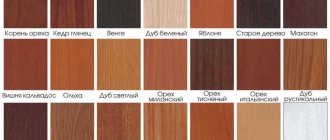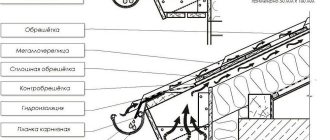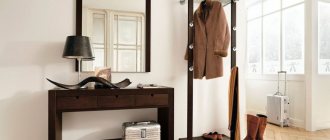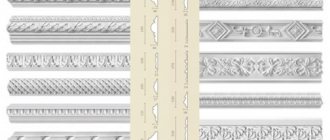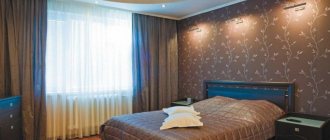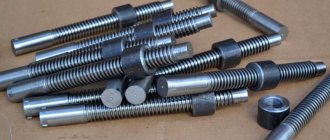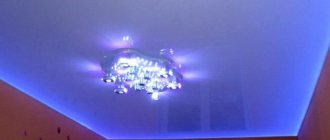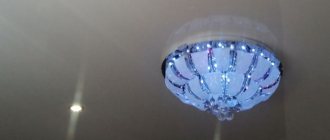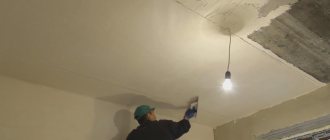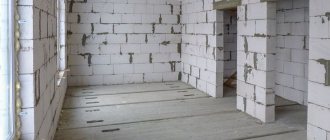What it is
A clamp is a specially shaped metal bracket to which the covering material (plastic, wood) is attached. In turn, the clamp is installed in the battens using nails or self-tapping screws (depending on the frame material). You can select clamps based on the type of coating, the thickness of the lining and based on the material of this fastening element. Mainly, staples are made of alloy steel or iron coated with a layer of zinc.
Photo - gluer for chipboard
Mainly, fastening the lining with the help of clamps is done in order to hide the installation site. When fastening, a small recess is cut into the board, which is inserted into the protrusion of the bracket. This is an excellent alternative to classic self-tapping screws, which cannot always be used for installing eurolining or MDF sheets on walls.
Photo - installation example
This fastener has many advantages:
- Safety of wood and plastic building materials. MDF and chipboard panels may begin to crumble when installing screws, while the tongue protects them from destruction;
- Installation can be done on any surface and in any room (bathhouse, kitchen, terrace);
- The fastener is completely invisible. This is very convenient, because after completing the installation work you will not have to paint over the joints, as when working with self-tapping screws;
- If necessary, the casing can be easily dismantled.
Separately, it is necessary to say about the service life. On average, staples made of steel and galvanized iron will last from 20 to 40 years, the service depends on the characteristics of the room (moisture level, condensation, temperature changes). The disadvantages of fastening include the relatively high cost of the elements. The prices of lining clamps can be two to three times higher than the cost of standard screws and nails.
The procedure for working with a lining clamp
If you are faced with the task of attaching the lining to the clamp, then the first thing you need to do is mark certain places based on the position of the frame beams, then attach the clamp to them, inserting it into positions, and secure it to the sheathing (screws, self-tapping screws, nails or staples are used for this) .
The next question is how to choose clamps for lining. And the choice ahead is not particularly difficult. They are mainly classified according to the size of the tongue, which can range from 1 to 6 millimeters; its size directly depends on the characteristics of the lining, in particular on its thickness. There is no particular dependence on the material used in production, wood or plastic.
It should be noted that there is a significant increase in installation speed when using this type of fastener for lining as a clamp. Also, a feature and the main advantage of using this kind of fasteners is the complete absence of the risk of damaging the material, which is quite important in this case, since when working with wood or plastic, surface damage is quite common.
No. 1. Features of lining installation
It is recommended to attach the lining to a pre-installed frame. If the walls or ceiling have a perfectly flat surface, it is possible to install the lining without constructing a frame, but the lathing still helps to extend the service life of the base surface and allows you to create an additional layer in the space between the lining and the main surface for laying heat-insulating material.
The lathing is attached in increments of 50-60 cm; it is imperative to use a level to achieve a perfectly flat surface and compensate for unevenness of the base ceiling or wall. The frame can be made of metal profiles or timber. When it comes to wooden lining, it is better to choose timber. It's all about the ability of wood to absorb and release moisture, changing in volume. The lining and timber will react in a similar way, but the metal does not change in volume, and if the profile is rigidly fixed to the surface, the lining may move. Of course, this risk remains when using a wooden frame, but still to a lesser extent.
Heat-insulating material can be laid between the sheathing bars, which is important not only for residential buildings, but especially for baths and saunas.
You can install the lining in one of the following ways:
- horizontally. This is probably one of the most popular options for installing lining. Some types of material (quarter and American lining) can only be mounted in this way. If we are talking about arranging a steam room, then it is necessary to place the slats with the spike facing up. Only in this way will condensation and water roll freely down the wall. In this case, installation of the lining begins from the ceiling;
- vertically. This installation allows you to visually raise the ceiling in the room; it is often used in baths. Installation of lamellas begins from any corner, the first element is installed with the groove outward. When attaching the lining to the ceiling, it is recommended to work in the direction from the light to avoid the appearance of shadows between the boards;
- diagonally. This is a decorative installation option that is often used when decorating walls and ceilings in living rooms;
- Combined and patterned installation involves installing lining lamellas in different directions, so you can get an original pattern. Unlike all the others, this installation option requires proper skill and preparation, so it is not suitable for beginners.
The direction of the sheathing bars will be perpendicular to the direction of the lining, this goes without saying.
How to attach lining to clamps
When the lining and type of fastening are chosen, the question usually arises of how to fasten the lining with clamps. This process is quite simple, but to make the work easier, you can watch special training videos.
Carriage panels can be installed both horizontally and vertically, everything will depend on personal wishes. Vertical panels, for example, will visually enlarge a room, while horizontal panels will visually make a narrow one a little wider. And the installation method will be selected depending on the type of fastening of the lining.
When a vertical mount is chosen, the first plank is mounted in a corner, leveling it with a level. In the middle of the carriage panel, in a special groove, a bracket is fixed, which is attached to the frame with nails or screws. The third part, which is picked up, is cut off from the subsequent plank and attached under the first. The element that remains is mounted in the groove to the first panel.
For each carriage strip, fasteners for the carriage are installed, about 4 pieces. All of them must be screwed to the frame to avoid deformation of the entire coating in the future.
The second and subsequent carriage panels are inserted into the grooves of the already installed ones, and on the reverse side, they are mounted with special fasteners to the sheathing.
When it is customary to sheathe walls with panels horizontally, the planks must be attached with the tenons facing upwards. This will promote better ventilation, and therefore mold and mildew will not be as dangerous, as well as preventing the collection of water or dust between the carriage slats. Car panels are mounted with horizontal lining from bottom to top. On the bottom row, the staples should be fixed a couple of millimeters above the floor. And the edge panel is cut so that the remaining distance is completely covered.
This work is quite painstaking, so there is no need to rush here. And in order for the wall cladding to turn out perfectly smooth, it is necessary to regularly check with a level how all the cladding elements are laid.
How to choose the right clamps
You can select clamps for installing lining and plastic according to the dimensions of the panels and their materials. Brackets are classified by the size of the tab or tab that is used to support the mounting plate. There are these types:
- For installing chipboard. The thickness of the elements is 4 mm;
- For installation of plastic lining and MDF. Up to 2 mm;
- To fasten eurolining panels, staples up to 4 mm thick are used;
- For classic wooden lining, 5 mm fasteners are used;
Also, in some cases, sheet sizes are selected individually, depending on the thickness and material of the panels, as well as the location of their installation. It is most convenient to buy fasteners in bulk, this will significantly save your time and money.
In construction stores, the classification of clamps is carried out by numbers. For example, when installing aspen panels, brackets 5 and 6 are used for the ceiling, and for eurolining 4. Check the information directly with the seller so as not to confuse the fasteners.
Photo - steel clamp
In the process of choosing clamps, a prerequisite is that you need to take into account the thickness of the material used for finishing work
It is very important to use only those brackets for lining that correspond to the dimensions of the product that you plan to use for cladding a particular structure
If we talk about the consumption of these fasteners, then you will need about 20 pieces to finish one square meter. Clamps have a relatively low cost, so you can safely purchase these parts with a reserve - in any case, it will cost you less than buying other types of hardware.
The main requirement when choosing clamps for lining is size. Based on the parameters of your panels and the type of material, determine the appropriate fastener option so that they provide the expected reliability of the coating, but are invisible after all finishing work is completed.
Having decided where to buy clamps for lining, consider the following recommendations for their intended purpose:
- staples up to 2 mm - the optimal solution for assembling structures from plastic panels and MDF boards;
- 3 and 4 mm fasteners are purchased when clamps are needed for eurolining or chipboard;
- 5 mm fasteners - to solve the problem of how to fasten lining made of wood, especially species such as aspen, linden;
- 6 mm products are used for blockhouses.
- steel strength;
- integrity of galvanization;
- consistency of dimensional parameters of the entire batch.
The described fasteners for lining are so common among consumers today for many reasons. Among others, we can highlight the possibility of carrying out installation work in a room whose conditions are characterized by a high level of air humidity. Among other things, such fasteners are quite simple to use; even a worker who does not have enough experience can perform the manipulations.
The main requirement when choosing clamps for lining is dimensions.
Based specifically on the characteristics of your panels and type, determine a suitable fastener option so that they provide the expected reliability of the coating, but are invisible after all finishing work is completed.
Having decided where to purchase clamps for lining, consider the following tips for their intended purpose:
- staples up to 2 mm average solution for assembling structures from plastic panels and MDF boards;
- 3 and 4 mm fasteners are obtained when clamps are needed for eurolining or chipboard;
- 5 mm fasteners to solve the question of how to fasten lining made of wood, especially species such as aspen and linden;
- 6 mm products are used for blockhouses.
- steel strength;
- integrity of galvanization;
- consistency of dimensional characteristics of the entire batch.
What clamps for lining exist currently?
To select brackets for the lining, you need to know the height of their tongue. Currently, several types of lining are used, which differ in their thickness and weight.
Correspondence of clamps to a certain type of lining:
- For plastic products or those made from MDF, parts are used whose height is approximately 1 or 2 mm.
- When using eurolining, the only option is to use fastening brackets with a height of 4 mm.
- To strengthen materials such as chipboard, you will need clamps whose height is 3 mm.
- For wooden lining, fastening brackets are used, which have a height of about 5 mm.
- When installing a blockhouse, craftsmen strengthen the material using clamps with a height of 6 mm (as shown in the photo).
Rules for calculating gluers and their use when fastening
Experience in using clamps shows that for reliable and durable fastening of one square meter it is quite enough to select about ten pieces.
- For a more accurate calculation, it is necessary to measure the length of one panel. After this, we measure the pitch of the sheathing frame. Typically this distance ranges from 40 to 60 centimeters. Divide the length of the panel by the pitch of the sheathing and add one. We multiply the result by the number of panels. This will be the required amount for fastening.
- When choosing the type of product used for fastening the panels, it is necessary to take into account that each element must be fastened with two or three self-tapping screws. It is not worth saving on their quantity, as this may affect the reliability and quality of installation as a whole. To fasten heavy panels, thicker reinforced elements with a large number of attachment points are used.
- After calculating the number of gluers, you can begin installing the panels. The wall on which installation is planned is pre-treated with special antiseptic solutions to eliminate the possibility of fungus formation. Subsequently, clamps are installed on the wall or installed sheathing using nails or self-tapping screws. In this case, nails are used only if lathing is used.
- Since the use of lining requires a flat surface, if there are uneven walls, you should calculate the best way to level them. Perhaps leveling the wall surface using a special solution or installing sheathing.
- Very often in such cases, lathing is used, which is installed on the wall surface quickly, and installation can be carried out on it immediately. Usually the sheathing is made of wooden beams of the same thickness, which are fixed at a distance of about one meter from each other. When installing wooden lining, this distance is somewhat smaller and is about 50-60 cm.
- When installing the sheathing beam, you need to constantly monitor the plane of the resulting surface, which should be flat. If necessary, to obtain a flat surface, plates of the required thickness are placed under the beams.
- Applying leveling solutions takes a lot of time, after which they also need time to dry. Therefore, this option is used much less frequently and when such work is necessary.
- Having installed the fasteners for the first panel, they begin to install it and then attach the clamps for the next one. The first board is tightly inserted into the hooks of the clamps, the rest are mounted in the same way. This method ensures that each panel fits accurately and securely against each other.
- To ensure high-quality installation with natural further ventilation, it is necessary to take into account that the boards should not touch the wall surface. Otherwise, this will lead to limited ventilation, moisture accumulation, and the formation of mold and mildew.
- When working with lining and clamps, it should be noted that work should be carried out at an ambient temperature of at least 10 degrees, since deformation of the panels may occur at lower temperatures. The clamps must be made of stainless materials and are treated with a special protective coating, since rust can spread over the surface of the lining.
- Liquid sealant cannot be used at the joints of wooden panels, but it is better to choose a moisture-proof film for this. Its use during temperature changes can lead to cracking of the panels. After installation is completed, the surface of the lining should be treated with special protective antiseptic materials that increase its resistance to precipitation and ultraviolet radiation.
- Taking into account all the requirements for choosing clamps for lining will ensure reliable and durable installation, as well as a long service life of the installed coating.
To learn how to attach clamps for lining, see the following video.
Features of work
Unlike plastic panels, wooden lining has a number of features that you should not forget about during work.
- Try to maintain the indoor temperature at least ten degrees compared to the street. Low temperatures lead to wood deformation.
- Make sure that the clamp used and all materials used during installation are made of stainless materials. This is especially important for interior decoration.
- Do not use liquid sealant on wood joints. To protect against leaks, it is better to secure a moisture-proof film under the facing layer.
- After installation, coat the lining with a special antiseptic. It will significantly increase the resistance of wood to ultraviolet rays and precipitation.
Installation subtleties
Installation of clamps is carried out using a screwdriver, building level, tape measure, square, hammer, screwdriver and marker. The first stage of work should be the preparation of the working base by leveling the surface or, if necessary, installing lathing. The evenness of the base is determined using a laser or a building level. All protruding parts must be removed, and large cracks, chips and deformations must be eliminated using a cement-sand mixture.
After this, you should perform an antiseptic treatment of the base and wait until the surface is completely dry. Then you can start marking the places where the clamps will be installed. It should be taken into account that when the slats are positioned vertically, the installation of hardware should be planned at a distance of the width of the board from the adjacent wall. When positioned horizontally, you should retreat 2-3 mm from the floor, which is necessary for screwing in the self-tapping screw.
Particular attention should be paid to the clarity of the location of the first element, since the correct installation of all subsequent planks and the appearance of the cladding as a whole will depend on it
The installation of clamps and lining slats occurs alternately, so the main thing is to strictly follow the installation order and ensure the parallel arrangement of the elements. The use of nails as fastening elements for the bracket is permissible only when installed on a wooden sheathing. In all other cases, you should use screws or dowels, depending on the size of the bracket and the weight of the wooden planks. Then you should begin installing the clamps, and you must ensure that the board lies evenly: without moving to the side or disturbing the general laying order.
In order to facilitate screwing in the screws, you should first mark the necessary places with dots. After installing the first brackets, you need to begin installing the lining, simultaneously fixing the next brackets. The first lamella is installed into the hook of the bracket, and then subsequent strips are inserted into the ridge with a groove. The next bracket should not be secured until the first panel is completely level. The end part of the lamella, equipped with a ridge, must be pressed tightly to the base, and at this time, insert a clamp into the groove from the back side and secure it with self-tapping screws.
Following this installation method, you need to complete the installation of the material, periodically checking the readings of the building level. After installing the last board, you need to cover the metal fastening elements with a wooden side.
Claypers as a type of hidden installation of lining
Claymers are one of the options for installing the finishing of hidden premises. They are special shaped brackets that are installed on the surface of a wall or other base using ordinary self-tapping screws, as well as nails. A specially shaped protrusion-hook on the clamp serves for further fastening of panels to it.
They are used for fastening various materials.
- Hanging elements of facades made of stone or tiles up to 14 mm thick. For the installation of natural stones, reinforced products are made, designed for a thickness of up to 40 mm.
- Facade cladding with large aluminum elements.
- Elements of flooring, for example, decking boards.
- Skirting panels.
- Various panels having different sizes inside the building.
- Linings of various profiles and from various materials.
Claypers are made on special equipment by stamping from ordinary and special strip steel, as well as from aluminum. After this, they are coated with an anti-corrosion coating, most often zinc.
The use of clamps for installation has a number of specific advantages and disadvantages.
- There is absolutely no possibility of damage to the panel material during installation. This is due to the fact that when using them, holes do not appear. While when fastening lining panels with nails and self-tapping screws, there are always holes from which cracks can form in the future; moisture can get into them and cause the material to rot.
- Clasps are hidden fasteners that are not visible from the outside. This improves the appearance of the room, and the walls look beautiful and stylish as a single whole, without nail heads or self-tapping screws.
- This is a very easy-to-use type of installation that does not require special tools.
- The durable metal bracket is very reliable and lasts for many years.
When choosing clamps, you should take into account that they are available in different thicknesses
, which is chosen taking into account the weight of the structures being fixed. So, the usual one, the most common, has a thickness of about 0.5 mm, and the reinforced version is about 1 mm or more. If you are planning to use clamps for fastening, you should take into account that in this case the panels to be fixed must have a margin of gap thickness, calculated taking into account the thickness of the fastening used. Otherwise you won't be able to use it.
To do this, you need to take panels from different packs and insert them into each other along with a clamp. In this case, everything must fit tightly, without unnecessary gaps, otherwise the installation configuration will change.
The main advantage of clampers
As has been mentioned more than once, the main advantage of this is its reliability.
It should also be taken into account that the most reliable design of the machine is the installation of which uses clamps for lining made of galvanized metal, half a millimeter thick.
The choice of this particular type of fastening element is due to its inherent protection against corrosion, which allows the use of such fastening both with and with.
Speaking directly about the consumption of fasteners, you won’t need many of them. Approximately twenty units are used per square meter of finishing material. Moreover, this element has a fairly low cost, which will be somewhat cheaper than purchasing other types of fasteners.
How to attach?
Installation of the cladding begins with fastening the sheathing to the desired surface. Even if the surface of the wall, ceiling or floor is fairly flat, sheathing allows you to create a flat and level plane, provides the opportunity for ventilation, and also provides space in which a variety of cables and insulation can fit. The lathing can be made from wooden blocks, or it can be assembled from metal, as for attaching drywall. For the installation of wooden lining, wooden lathing is better suited, especially in a bathhouse and sauna, since the wooden lathing “plays” with the wall and prevents the wood material from cracking when it shrinks and swells, depending on humidity and atmospheric conditions.
You need to decide in advance on the direction of the wall covering. There are 4 options with which you can fasten the panels to the sheathing: horizontal, vertical, diagonal, combined. It must be taken into account that the direction of the lathing strips should be perpendicular to the direction of the lamellas of the finishing material used. For horizontal installation, the first plate must be secured horizontally with self-tapping screws or nails at a distance of 1-2 mm from the floor or ceiling.
This fastening will later cover the ceiling or floor plinth. We install the clamping tongue into the groove of this board, and screw its base with self-tapping screws or nail it to the sheathing. We insert all subsequent panels with grooves into the ridge of the previous one and securely fix them to the sheathing bars.
For a more reliable connection, you can secure the sheathing by attaching the boards more tightly to each other, lightly driving them into the grooves using a mallet and a tamping board. If necessary, cut the last strip to size to the required width. When laying panels horizontally in a steam bath, they begin to be installed from the ceiling so that the tongue of the lining is directed up the wall and the groove down. This is necessary so that condensation does not accumulate in the lining, but flows freely down the wall.
When installing vertically, the starting board is nailed vertically from the beginning of the sheathing, positioning it close to the sheathing and driving a nail into the ridge of the lining. The nail heads on the first board can be removed using a side cutter or covered with decorative strips. You need to install clamps in the groove of the first board and secure them with nails or self-tapping screws to the sheathing. Place the tongue of the next board into the groove of the previous one.
We use a rubber hammer to fit the lining panels into each other more tightly. And then, using clamps, we install all the finishing materials. We also cut the last panel to size. With this installation, you need to check the correct vertical installation using a plumb line every 7-10 panels. Vertical cladding is suitable for rooms with high humidity - saunas, baths, verandas, for upholstery from the street, as it does not allow moisture to accumulate in the grooves of the lining.
Diagonal and combined installation requires sufficient skill and professionalism, so it is better to entrust such cladding to a specialist with sufficient experience. This type of cladding is most often used to decorate walls and ceilings indoors.
See the video for all types of clamps, what they are used for and how they are attached.
Marking the base
The markings should be applied depending on the direction in which the lining will be located. Directionality can have both a decorative and practical function. For example, in baths and steam rooms it is recommended to give preference to the vertical cladding method, so that moisture settling in the seams between the boards does not accumulate and is able to flow down freely.
Vertical installation involves installing clamp connections at a distance from the wall that is equal to the size of the board and its width.
Horizontal markings should ensure that the bracket is located so close to the floor as to create access for a hammer to attach the clamp. To enhance the decorative effect of the finishing, diagonal laying is also used, or several methods of installing lining are combined to obtain unusual patterns on walls or ceilings. These methods are typical for residential premises. In this case, the work is difficult to complete without experience and training. The sheathing is usually installed perpendicular to the direction of the boards.
Self-tapping installation
Through fastening with self-tapping screws through the entire board, and not through a groove, is the simplest, fairly reliable, but not the best solution for wooden lining. With this method, the integrity of the material is compromised, so the holes must be regularly treated with special protective mastics to prevent destruction and rotting of the wood. Despite all efforts, over time, the installation sites of fasteners may become noticeable, which significantly impairs the aesthetics of the decorative finish. Usually the first and last panels are mounted this way for reliability, and for the rest they use fastening with finishing nails or clamps.
What is a kleimer?
Clamps are brackets for fastening finishing materials, such as lining, MDF panels and plastic boards. They are made of galvanized metal (to prevent corrosion). These hardware are attached to the surface using nails or self-tapping screws. As a rule, decorative materials are attached with their help to the sheathing, less often - directly to the wall.
Advantages of clamps over other fasteners
This is an affordable fastener that is sold at any hardware store. It is recommended to buy them in specialized establishments to avoid purchasing low-quality materials.
If you calculate the costs of these hardware, then their acquisition will cost more than self-tapping screws or nails, which also often act as the main fastening of the lining. The savings will lie in something else. Fastening with brackets is more economical due to the fact that chips or cracks do not appear on the panels themselves. With nails and screws the opposite is true, and you often have to buy replacement lining panels to replace damaged ones.
They are attached to the wall or sheathing, and then the lining strip is inserted into special grooves. The advantages of this material include:
- Installation is several times faster;
- When using clamps, the lining panel is almost impossible to damage;
- They can be installed in rooms with high humidity due to a special coating that prevents corrosion;
- Varieties of hardware, which differ from each other in size, allow you to choose an option for hidden installation of panels of any size;
- Thanks to reliable fixation, the lining will not begin to shift or deform over time;
- The clamps are highly durable and not subject to destruction.
But why do many people prefer fastening the lining with clamps? Unlike nails and self-tapping screws, as mentioned above, they significantly reduce the chance of damaging the lining and do not lead to additional waste. They are more practical and convenient to use and allow for seamless installation.
Useful tips
Beginning builders often encounter typical problems during installation. You can avoid this by adhering to the following recommendations:
Wooden lining joints cannot be sealed with liquid sealant.
This can lead to corrosion of the clamps and affect the condition of the decorative panels themselves.
Installation work is carried out only under suitable temperature conditions: the difference in temperature outside and indoors should be a maximum of 10 degrees. If wooden lining is used, installation is carried out only in positive temperatures. For plastic panels, the temperature regime is also important: the thermometer should show at least 10 degrees Celsius.
To prevent rotting of the panels and corrosion of fasteners, after installation is completed, the lining must be treated with a special coating (wax, stain, varnish).
To maintain the beautiful appearance of the finishing material, installation of the planks in a horizontal manner begins from the top corner. This way, if it becomes necessary to cut the last plank, the cut area can be covered with a wooden plinth.
If there are sockets and switches in the room, holes for them are made only after installing the lining, but before covering it with varnish.
The finishing material, immediately after purchase, must be left in the room for a couple of days so that it “gets used” to the atmosphere in the room. This will help avoid difficulties from contraction (expansion) of the tree due to changes in the microclimate.
Decorative panels cannot be attached directly to the wall (ceiling). Otherwise, it will impede free ventilation and lead to mold, dampness and mildew. Especially if the lining is installed in a room with high humidity.
When purchasing fasteners, pay attention to the material from which they are made. It must be similar in type to the finishing materials and be immune to temperature changes and high humidity. This is especially true for the interior decoration of baths, saunas and steam rooms, or the exterior cladding of a building.
What are clampers, their advantages
The high consumer demand and popularity of clamps are due to the many undeniable advantages of this type of fastener.
- The simplicity of the design and the uncomplicated installation process allow you to independently cladding the room without resorting to the services of specialists, and strict adherence to the installation technology will significantly reduce the time required to complete the work.
- The use of staples eliminates drilling, nailing and other mechanical impact on the lining slats, making the appearance of cracks and chips impossible. This is one of the advantages of using fastening clamps over installation carried out using self-tapping screws, nails and screws.
- The large size range of models allows you to create a neat seamless coating even when using the technique of combining lining with other finishing materials.
- Reliable fixation, which is achieved using clamps, completely eliminates the risk of deformation and shifting of the coating.
- Claymers are highly resistant to aggressive environmental influences and high humidity, so they can be used both in conditions of negative temperatures and when finishing baths and saunas.
- Comfortable price. The price of clamps compares favorably with the price of other types of hardware.
- The versatility of the design allows the use of brackets when installing lining on any rough surface, including wood, concrete, cinder block, cement bases and sheathing.
The disadvantages of lining clamps include insufficient reliability under the influence of increased loads or vibrations of the foundation.
Clamps are made of galvanized iron or spring steel. They are special brackets for fastening the lining, which are installed on the wall or sheathing using self-tapping screws or nails. Clippers are also used for fastening plastic boards and fixing MDF panels.
Clamps for fastening lining are easy to purchase at any hardware store, and the low price is another advantage. Of course, buying nails and screws is a little more profitable, but the practicality of use and ease of installation with their help completely justify these costs. But besides this, there are a number of other advantages:
- The construction process is 2-3 times faster;
- Installation using clamps completely eliminates damage to the finishing material (cracks and chips), due to the fact that the lining panel itself does not need to be drilled or nailed for fastening;
- This fastening element is not afraid of constant exposure to high humidity. And it is best suited for use in rooms like a bathhouse;
- Easy installation: even an inexperienced person can master the technology of using clamps;
- There is a wide selection of clamps that differ in size, and this will allow you to choose a fastening element that will facilitate fastening in a hidden way and without seams;
- Reliable fixation of finishing panels, without possible shifting in the future;
- The clamps are very reliable, not subject to corrosion and destruction, and are highly durable.
Installing lining using clamps
The emergence of new materials also expands the list of methods for their installation. In this regard, lining is not a revolutionary means of cladding, but requires the use of special fasteners in installation . Of course, installation using conventional nails and self-tapping screws is theoretically possible, but a durable and aesthetically attractive result can only be ensured by clamps for lining of the appropriate standard size. The fastening operation is somewhat more complicated, but the boards form a neat and securely fixed finishing coating .
What are claymers?
A clamp is a bracket , the design of which is designed to ensure the fixation of lining elements. A special feature of this fastener is that it matches the shape of the boards, taking into account the grooves and tenons. The clamp itself is pre-mounted on the surface of the base , which can be represented by both the rough surface of the wall and the sheathing. In the first case, the use of special hardware is required to securely fasten the element.
In the case of wooden sheathing, it is easier to install the clamp. It has holes through which fastening is carried out using self-tapping screws, nails or screws. In general, the procedure for installing the bracket is simple and does not require special skills. Next, the boards are secured using hooks. Depending on the design of the clamp, additional tenon hooks may be provided.
Return
Varieties and sizes
There are several classifications of clamps that allow you to systematize the existing assortment, thereby facilitating consumer choice. First of all, you need to decide on the height of the bracket tongue. The minimum standard size is represented by elements with a height of about 1 or 2 mm . Next come the clamps for the lining, the height of which reaches 4 mm . Such models are usually used for eurolining. If you plan to cover it with chipboard materials, then it is advisable to use clamps with a tongue height of 3 mm.
Standard wooden forcing boards are usually attached to 5mm pieces. The maximum standard size is considered to be a fastener with a tongue height of 6 mm. This option is suitable for installing a blockhouse that imitates the log surface of houses. The thickness of the clamps is also important, since high mechanical loads can compromise the integrity of the skin.
Return
Advantages and disadvantages of installation
The main advantage of using clamps is hidden installation , which involves the formation of a wooden plank finish without traces of installation. This is especially noticeable if we compare methods of similar installation using screws and nails. In such cases, not only there is a risk of leaving external damage on the surface of the boards, but also it becomes impossible to disguise the caps. In this sense, cladding clamps provide reliable fastening without disturbing the appearance of the cladding .
Another advantage of clamps is wider possibilities in choosing the method of main fastening, to the wall or sheathing strips . Since the results of this operation will not be visible, you can use almost any means of fastening that can be combined with the standard size of the clamp itself.
But there are also disadvantages to such brackets - their cost and, nevertheless, insufficient strength for operation in conditions with increased loads on the walls. If vibrations of the foundation and walls are expected, then the clamps may simply not cope with their function.
Return
Calculation of staples
For all the advantages of clamps, you will have to pay for careful preparation for installation . This is a labor-intensive stage on which the quality of the entire work depends. Firstly, it should be noted that the staples are selected in accordance with the standard size of the boards. Secondly, if you plan to vertically fasten the lining using clamps, then the fixation should be carried out at a distance from the wall equal to the width of the plank.
If horizontal installation is carried out, then the staples must be installed 2-3 millimeters from the floor so that there is room for attaching a nail or tightening a self-tapping screw.
The calculation of the number of clamps can be determined by the following proportions:
- 4 elements with a standard size of 1-2 mm, if a flat surface is to be covered. The step in this case is approximately 40-50 cm;
- 5 elements per 1-2 mm, if finishing the extreme areas. The step will be 35 cm;
- 6 elements with a tongue height of 1-2 mm, if you plan to cover corner areas. The step will be 25 cm.
When using parts with a large standard size, accordingly, the step will either increase or the number of elements used will decrease.
Return
Fixation of clamps
At this stage, the sheathing or smooth surface of the wall should be prepared. If you plan to fasten the staples with nails, then you should arm yourself with a hammer and a level, in the case of self-tapping screws - a screwdriver or screwdriver . To understand how to fasten the lining with clamps, it should be noted that the fixation of fasteners and wooden panels will be carried out alternately. The operations are simple, but it is important to maintain accuracy in calculations and position of the fastener . Particular attention is paid to the first part, which sets the direction for all subsequent planks.
Nails can only be used with existing sheathing. If it is not there, then you need to install it with dowels or self-tapping screws. For this, bars with a cross-section are used that will provide approximately a 5-centimeter gap . Then the clamps are installed. Each element is nailed so that the lining board lies flat on it horizontally or vertically .
If a self-tapping screw is used, then, again, it would not be superfluous to provide a sheathing. This will make it easier to fix. Next, you can either prepare holes that are thinner than the diameter of the screws, or screw them in at the designated points . When the first clamps are secured, you can begin installing the lining and simultaneously fixing subsequent brackets.
Return
What should you consider during installation?
To successfully install lining using clamps, the following nuances must be taken into account:
- The boards should not be in direct contact with the surfaces of the floor, ceiling or wall. That is, a tight fit to them should be avoided in order to ensure ventilation;
- It is quite possible that you will have to sheathe a surface on which there are niches for an outlet or other electrical devices. In such a situation, you should also carry out installation, and then cut out the corresponding holes with a flared saw - as a rule, a diameter of 5.5 cm is enough;
- The free space between the floor and the casing can be hidden with a skirting board that matches the texture.
Return
Preparing the base
A perfectly flat surface is necessary so that the plastic or wood material is correctly installed, and there are no visible gaps, depressions or protrusions between the panels.
Therefore, installation of the frame is a necessary stage of such finishing work.
It can be assembled from wooden blocks, a metal profile and special plastic guides, in which grooves are already made for attaching clamps.
The step between the bars of any type of sheathing should not exceed 60 centimeters. And the distance between them can, if necessary, be filled with heat-insulating material. The simplest material for assembling a frame, of course, is wood (except for rooms with high humidity, such as a bathroom, bathhouse, sauna).
But it should be remembered that wooden blocks may rot over time, so it is advisable to coat them with a special antiseptic in advance, which will protect them from biological damage for many years.
Installation
Depending on how to attach the lining to the clamps, vertically or horizontally, the installation method is also selected.
When the cladding is in a vertical position, the first panel is installed in a corner and leveled using a level. In the middle of the lining, a bracket is installed in the groove and attached to the sheathing using nails.
When installing vertically, 3-4 clamps for lining are screwed onto one panel. Each of them must be secured with several nails to the sheathing bars in order to avoid deformation of the structure in the future.
The next finishing board is inserted into the groove of the one that is already installed, and on the other side it is mounted using fasteners to the frame.
Video editing using this technology:
The sauna is finished horizontally
If the cladding is mounted horizontally, then the plates are fastened with the tenons facing up, which improves ventilation and prevents the accumulation of water and dirt between the grooves of the panels.
Installation of horizontal eurolining is carried out from the bottom up, and the brackets of the first row are attached a few millimeters from the floor. In this case, all panels should be fastened to clamps to each block.
The last board or plastic panel should be cut to tightly close the remaining gap.
Conclusion
Installation using clamps has a number of advantages and is a modern alternative to fastening with finishing nails or a stapler. If the surface covering is carried out in compliance with all the rules and instructions, then it does not present any difficulties and is accessible even to a non-professional builder.
Important points
When attaching the lining to such brackets, you need to keep in mind some details:
- There should be some space between the lining panels and the wall for ventilation. That is, it is impossible to tightly attach the bar to any surface, otherwise harmful microorganisms may settle there,
- if the lining is attached to a wall on which there are sockets, then first the entire wall is covered with slats, and only then the corresponding holes are cut out using a saw,
- when the entire surface is covered with clapboard, small gaps remain at the joints, bottom and top, which are masked with special skirting boards that match the texture of the finishing material.
Using a lining clamp as a fastener, you can get a number of advantages, since this modern technology is the safest for surface cladding. If you strictly follow all the rules and also adhere to the prescribed instructions, then there will be no problems with such fastening, and even an unprofessional craftsman can cope with it.
